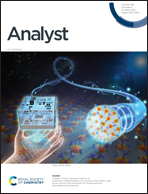Broadband cavity enhanced UV-VIS absorption spectroscopy for picolitre liquid samples†
Abstract
Absorption spectroscopy is a widely used analytical technique due to its label-free nature, however its application to small liquid samples is hampered by the associated short absorption pathlengths, which limit sensitivity. A novel concept for the development of an ultrasensitive broadband absorption spectrometer optimised for thin liquid films is presented here. To enhance sensitivity of the absorbance measurements an optical cavity is implemented on a fibre-based absorption spectrometer (CEASpec). Light is circulated multiple times through the sample of interest to increase sensitivity. The bandwidth of the instrument is chosen by the choice of the dielectric mirrors forming the optical cavity spectra and, in this implementation, has been set to be 200 nm wide (250–450 nm). The sensing volume of the spectroscope is prescribed by the choice of optical fibres employed to deliver light to the sample, and in this implementation fibres of 400 μm in diameter were employed, giving a sensing volume of 630 picolitres for a thin film of 5 μm in thickness. Amphotericin B, a broad light absorber in the 280–450 nm region of the spectrum, was used here to prove the capabilities of the proposed cavity enhanced absorption spectroscope. Cavity enhancement factors, the equivalent pathlength increase over classical absorption spectroscopy, in the range of 200× have been achieved across a broad wavelength range.



 Please wait while we load your content...
Please wait while we load your content...